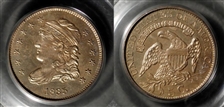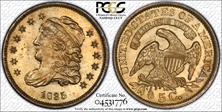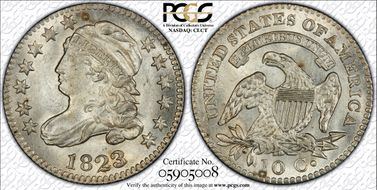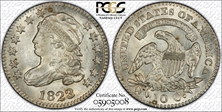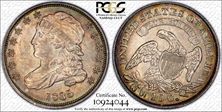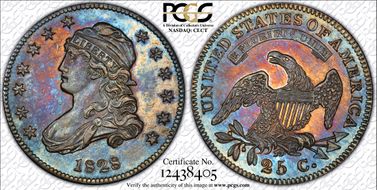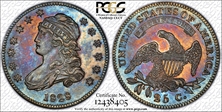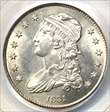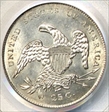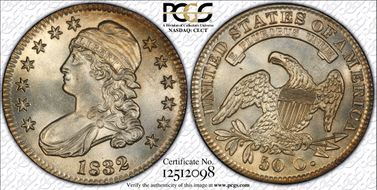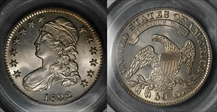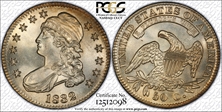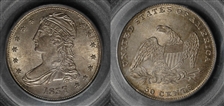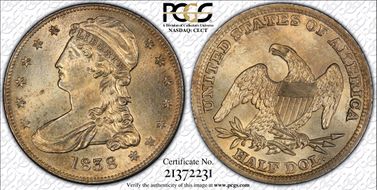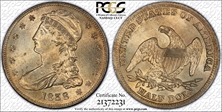Gobrecht's Raisinet Collection 的钱币相册
1835 H10C Small Date, Large 5C MS65. V-5, LM-8.2, R.2. Sun-gold toning is predominant, and the strike is excellent. The 1 in the date is high, and the tip of the feather is right of center of the 5 in the denomination. This late die state of this die marriage is more plentiful than the early die state.
1835 H10C Small Date, Large 5C MS65. V-5, LM-8.2, R.2. Sun-gold toning is predominant, and the strike is excellent. The 1 in the date is high, and the tip of the feather is right of center of the 5 in the denomination. This late die state of this die marriage is more plentiful than the early die state.
1835 H10C Small Date, Large 5C MS65. V-5, LM-8.2, R.2. Sun-gold toning is predominant, and the strike is excellent. The 1 in the date is high, and the tip of the feather is right of center of the 5 in the denomination. This late die state of this die marriage is more plentiful than the early die state.
1823/2 10C Large Es MS64 JR-3, R.2. A fairly common variety and the most common 1823 Dime - all being overdates. The overdate feature is clear with a loupe, as the base of the 2 extends to the right of the 3, and the neck of the 2 is visible within the lower loop of the 3. Diagnostically, the D in UNITED is over a previously punched E, obverse star 7 points to the upper edge of Liberty's headband (not at her upper curl, as it does in the JR-2), and the E in STATES is higher than the second S. There is a prominent center dot directly beneath Liberty's ear. Intensely lustrous, both sides shimmer with a fully original, satin-white texture. There are blushes of pale-apricot tinting here and there around the obverse periphery, but the overall appearance is one of radiant brilliance. Well struck throughout, most areas are actually sharply impressed from the dies. Minimally abraded and nearly qualifying as an MS-65, Condition Census for both the 1832/2 JR-3 die marriage as well as the Large Es. This variety is scarce as a near-Gem, and just one piece is ranked higher, at MS65, by PCGS (10/07).
1823/2 10C Large Es MS64 JR-3, R.2. A fairly common variety and the most common 1823 Dime - all being overdates. The overdate feature is clear with a loupe, as the base of the 2 extends to the right of the 3, and the neck of the 2 is visible within the lower loop of the 3. Diagnostically, the D in UNITED is over a previously punched E, obverse star 7 points to the upper edge of Liberty's headband (not at her upper curl, as it does in the JR-2), and the E in STATES is higher than the second S. There is a prominent center dot directly beneath Liberty's ear. Intensely lustrous, both sides shimmer with a fully original, satin-white texture. There are blushes of pale-apricot tinting here and there around the obverse periphery, but the overall appearance is one of radiant brilliance. Well struck throughout, most areas are actually sharply impressed from the dies. Minimally abraded and nearly qualifying as an MS-65, Condition Census for both the 1832/2 JR-3 die marriage as well as the Large Es. This variety is scarce as a near-Gem, and just one piece is ranked higher, at MS65, by PCGS (10/07).
1835 10C MS64 PCGS. JR-9, R.2. A gloriously toned, Choice Uncirculated example of this popular dime, this is a well centered and sharply struck late-date, Capped Bust coin. It has an attractive periphery of sea-green and gold toning that has accumulated over the years and beautifully circles and frames the sharply impressed centers on each side. Fancy 8 in date, with diagnostic Large 3 in the date repunched southeast. The 5 is high and has a curved flag. The 10th star touches a denticle. On the reverse RI in AMERICA touch, the first A is high and the second T in STATES is entered low.
1835 10C MS64 PCGS. JR-9, R.2. A gloriously toned, Choice Uncirculated example of this popular dime, this is a well centered and sharply struck late-date, Capped Bust coin. It has an attractive periphery of sea-green and gold toning that has accumulated over the years and beautifully circles and frames the sharply impressed centers on each side. Fancy 8 in date, with diagnostic Large 3 in the date repunched southeast. The 5 is high and has a curved flag. The 10th star touches a denticle. On the reverse RI in AMERICA touch, the first A is high and the second T in STATES is entered low.
1828 25C MS62 B-4, R.3 as a business strike, R.7 as a proof. The Narrow Date, B-4 variety has less space between the 82, relative to B-1 through B-3. This specimen is a striking and rather proof-like example of this difficult early quarter type, richly toned in sea-green, plum-red, tan-gold and cobalt-blue. The final date in the Large Diameter series of Bust quarters, and unquestionably original with rich tonal qualities, the striking details are well brought up in all areas and both sides are perfectly centered. The definition of what constitutes a proof has become more strict within past decades. Only a handful of 1828 quarters have been certified as proofs. Speculating on the possibility of it being a proof, the fields do exhibit a noticeable glimmer when held beneath a light, but the effect is somewhat dampened by the layers of toning.
1828 25C MS62 B-4, R.3 as a business strike, R.7 as a proof. The Narrow Date, B-4 variety has less space between the 82, relative to B-1 through B-3. This specimen is a striking and rather proof-like example of this difficult early quarter type, richly toned in sea-green, plum-red, tan-gold and cobalt-blue. The final date in the Large Diameter series of Bust quarters, and unquestionably original with rich tonal qualities, the striking details are well brought up in all areas and both sides are perfectly centered. The definition of what constitutes a proof has become more strict within past decades. Only a handful of 1828 quarters have been certified as proofs. Speculating on the possibility of it being a proof, the fields do exhibit a noticeable glimmer when held beneath a light, but the effect is somewhat dampened by the layers of toning.
1831 25C Small Letters MS64. B-4, R.1. Minage: 398,000. No quarters were struck in 1829 or 1830, and when the denomination resumed production in 1831, the diameter was reduced from 27 mm to 24.3 mm. The weight and alloy were unchanged, which implies that the new quarters were thicker. Half eagles also were reduced in diameter, beginning in 1829, but otherwise retained prior alloy and weight standards. These changes in diameter were made to conform to the new close collar technology introduced to the Philadelphia Mint. However, Capped Bust halves, which then dominated silver coin production, continued to be struck with lettered edges until the 1836 Reeded Edge halves were produced. This is a lustrous and brilliant silver-white example of the Capped Bust quarter dollar design. Star 7 points to lower curl, the lower right star is close to the hair, square based 2 in the denomination, eagle has long tongue, 25 C closer to eagle than dentils, 25 is high and the arrow heads are thin. There are remnants of die rust above and left of the final S in STATES. This is a later die state of the B-4 variety with a fine die crack through the C of the denomination to the stem above, and another connecting the lower left base of the A in AMERICA with the middle serif of F in OF. Repunching shows on the 5 of the denomination. This is Die State III in Walter Breen's revision of the Browning reference, apparently the most common die state of this variety. Only the barest glimpse of a golden patina accompanies this needle-sharp near-Gem. The strike is exquisite and a strong lens reveals only trivial contact. A wonderful type coin from the Age of Jackson from The Lanterman's Mill Collection.
1831 25C Small Letters MS64. B-4, R.1. Minage: 398,000. No quarters were struck in 1829 or 1830, and when the denomination resumed production in 1831, the diameter was reduced from 27 mm to 24.3 mm. The weight and alloy were unchanged, which implies that the new quarters were thicker. Half eagles also were reduced in diameter, beginning in 1829, but otherwise retained prior alloy and weight standards. These changes in diameter were made to conform to the new close collar technology introduced to the Philadelphia Mint. However, Capped Bust halves, which then dominated silver coin production, continued to be struck with lettered edges until the 1836 Reeded Edge halves were produced. This is a lustrous and brilliant silver-white example of the Capped Bust quarter dollar design. Star 7 points to lower curl, the lower right star is close to the hair, square based 2 in the denomination, eagle has long tongue, 25 C closer to eagle than dentils, 25 is high and the arrow heads are thin. There are remnants of die rust above and left of the final S in STATES. This is a later die state of the B-4 variety with a fine die crack through the C of the denomination to the stem above, and another connecting the lower left base of the A in AMERICA with the middle serif of F in OF. Repunching shows on the 5 of the denomination. This is Die State III in Walter Breen's revision of the Browning reference, apparently the most common die state of this variety. Only the barest glimpse of a golden patina accompanies this needle-sharp near-Gem. The strike is exquisite and a strong lens reveals only trivial contact. A wonderful type coin from the Age of Jackson from The Lanterman's Mill Collection.
1832 50C Small Letters MS64 PCGS. O-106, R.1. Mintage: 4,797,000. Star 1 is recut, instantly identifying this variety, and a tiny dotlike hole is seen at the lower shield vertex. The 5 in the denomination has a short, thick top. Line 1 of stripe 2 and line 2 of stripe 4 extend upward through two horizontal shield lines. The Draped Bust half dollar yielded to the perennially popular Capped Bust motif in 1807. In 1807 the Mint introduced a new half dollar design that collectors today have come to call the Turban Head or Capped Bust variety. This lovely near-Gem is highly lustrous with radiant silver-white surfaces and a bold strike. The coin is just a couple of trivial cheek abrasions away from full Gem status. Extremely high-end for the grade, and eye-appealing as well.
1832 50C Small Letters MS64 PCGS. O-106, R.1. Mintage: 4,797,000. Star 1 is recut, instantly identifying this variety, and a tiny dotlike hole is seen at the lower shield vertex. The 5 in the denomination has a short, thick top. Line 1 of stripe 2 and line 2 of stripe 4 extend upward through two horizontal shield lines. The Draped Bust half dollar yielded to the perennially popular Capped Bust motif in 1807. In 1807 the Mint introduced a new half dollar design that collectors today have come to call the Turban Head or Capped Bust variety. This lovely near-Gem is highly lustrous with radiant silver-white surfaces and a bold strike. The coin is just a couple of trivial cheek abrasions away from full Gem status. Extremely high-end for the grade, and eye-appealing as well.
1832 50C Small Letters MS64 PCGS. O-106, R.1. Mintage: 4,797,000. Star 1 is recut, instantly identifying this variety, and a tiny dotlike hole is seen at the lower shield vertex. The 5 in the denomination has a short, thick top. Line 1 of stripe 2 and line 2 of stripe 4 extend upward through two horizontal shield lines. The Draped Bust half dollar yielded to the perennially popular Capped Bust motif in 1807. In 1807 the Mint introduced a new half dollar design that collectors today have come to call the Turban Head or Capped Bust variety. This lovely near-Gem is highly lustrous with radiant silver-white surfaces and a bold strike. The coin is just a couple of trivial cheek abrasions away from full Gem status. Extremely high-end for the grade, and eye-appealing as well.
1837 50C MS64. The 1837 is one of only two issues of Christian Gobrecht's Reeded Edge, 50 CENTS Reverse Half Dollar. The Reeded Edge half dollars with "50 CENTS" on the reverse were the first U.S. regular-issue coin series struck on a steam press. The second and final year of the 50 CENTS reverse design, type collectors naturally gravitate to the 1837 since the 1836 is a famous, low mintage rarity, and technically a pattern issue. A paltry 1,200 pieces were struck the first year, and a more generous 3,629,820 coins in 1837, making this issue an important and desirable one for type collectors. The production of more than 3.6 million pieces appears generous, however, Uncirculated survivors are scarce, and only a slender portion of these pieces achieve status as a Gem. This near-Gem is a most impressive specimen, as its original surfaces give off glowing luster and medium intensity steel-gray toning. A few unobtrusive handling marks do not detract in the least. The design elements are evenly and fully struck in all areas, with 50 CENTS and all of stars fully impressed, enhancing the coin's outstanding eye appeal. A lack of consequential abrasions further contributes to the eye appeal.
A two-year type coin with the Capped Bust obverse, reeded edge, and HALF DOL. denomination, superseded in 1839 by the Seated Liberty half dollar. This piece shows generous luster over the silver-gold surfaces, with a sharp strike (save for star 12, often seen weak) and some striations near the obverse rim from 4 to 6 o'clock and correspondingly on the reverse, a phenomenon also frequently seen on this issue. Scattered traces of die rust appear, without in the least detracting from the premium appeal of this near-Gem half dollar.
A two-year type coin with the Capped Bust obverse, reeded edge, and HALF DOL. denomination, superseded in 1839 by the Seated Liberty half dollar. This piece shows generous luster over the silver-gold surfaces, with a sharp strike (save for star 12, often seen weak) and some striations near the obverse rim from 4 to 6 o'clock and correspondingly on the reverse, a phenomenon also frequently seen on this issue. Scattered traces of die rust appear, without in the least detracting from the premium appeal of this near-Gem half dollar.





















